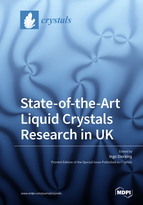State-of-the-Art Liquid Crystals Research in UK
A special issue of Crystals (ISSN 2073-4352). This special issue belongs to the section "Liquid Crystals".
Deadline for manuscript submissions: closed (31 May 2022) | Viewed by 26349
Special Issue Editor
Interests: liquid crystals; chiral liquid crystals; ferroelectric liquid crystals; polymer stabilized liquid crystals; nanoparticles in anisotropic fluids; liquid crystal-nanotube dispersions; defects and defect dynamics; phase ordering in soft matter; fractal structures
Special Issues, Collections and Topics in MDPI journals
Special Issue Information
Dear Colleagues,
The United Kingdom has a proud history of liquid crystal research, from the formulation of the theory of nematic elasticity, as it is used today, via the Leslie–Erickson theory describing the viscosity of mesophases, to the discovery of the first room-temperature nematic and the related developments in the display industry, to name just a few of the pioneering contributions. Today, liquid crystal science in the UK is more diverse and multidisciplinary than ever, ranging from the synthesis of increasingly complex mesogenic molecules, via the physical properties of self-organised systems and composites of both the thermotropic and the lyotropic type, to a wide variety of applications outside of the traditional display sector. The field covers aspects of Chemistry, Physics, Material Sciences, Chemical Engineering, Mathematics, Biology and Device Engineering in an overarching effort to advance the fundamental understanding of these soft-matter materials and to promote their technological exploitation in the UK and worldwide. To this end, a large group of individuals and research groups from universities and industry in the UK are working together. Their achievements can be found in publications in top class journals and presentations at all large international conferences, in the development of new products, and as events for public engagement.
This Special Issue of the journal Crystals is dedicated to providing an overview of the state-of-the-art of current UK liquid crystals research, compiled from review papers and original research articles, highlighting the breadth of the field today. Research topics include, but are not limited to:
- Synthesis of novel mesogens, self-assembly and novel phases;
- Polymer- and nanoparticle-composites, elastomers;
- Physical characterisation and electric and electrooptic effects;
- Lyotropic and chromonic liquid crystals;
- Bio-inspired systems;
- Frustrated phases and topological defects;
- Cellulose-based liquid crystalline materials;
- Theory of liquid crystals;
- Novel display and non-display applications;
- Liquid-crystal-based adaptive optics and photonics.
The only restrictions are that the contribution is mostly devoted to liquid crystal research and that the main part of the study was conducted in the UK or by UK researchers.
We hope that this Special Issue will depict the current state-of-the-art liquid crystal research in the UK and offer an overview of what is being achieved in the field in the United Kingdom.
Dr. Ingo Dierking
Guest Editor
Manuscript Submission Information
Manuscripts should be submitted online at www.mdpi.com by registering and logging in to this website. Once you are registered, click here to go to the submission form. Manuscripts can be submitted until the deadline. All submissions that pass pre-check are peer-reviewed. Accepted papers will be published continuously in the journal (as soon as accepted) and will be listed together on the special issue website. Research articles, review articles as well as short communications are invited. For planned papers, a title and short abstract (about 100 words) can be sent to the Editorial Office for announcement on this website.
Submitted manuscripts should not have been published previously, nor be under consideration for publication elsewhere (except conference proceedings papers). All manuscripts are thoroughly refereed through a single-blind peer-review process. A guide for authors and other relevant information for submission of manuscripts is available on the Instructions for Authors page. Crystals is an international peer-reviewed open access monthly journal published by MDPI.
Please visit the Instructions for Authors page before submitting a manuscript. The Article Processing Charge (APC) for publication in this open access journal is 2600 CHF (Swiss Francs). Submitted papers should be well formatted and use good English. Authors may use MDPI's English editing service prior to publication or during author revisions.






